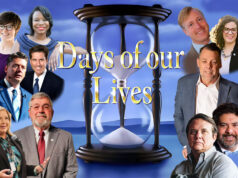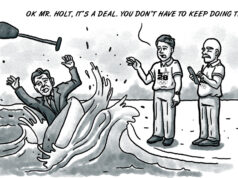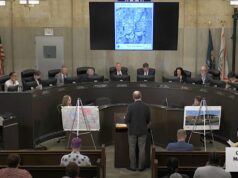
In the 1950s, Oklahoma City teacher Clara Luper and her students took the northern route on a bus trip to the NAACP conference in New York City, allowing many students to experience racially integrated environments for the first time. Their bus returned through the segregated South, and they set out to challenge their hometown’s separate and unequal system upon returning to Oklahoma.
For 15 months, Luper and her followers tried to persuade local business leaders in Oklahoma City to take down the walls of separation. The sit-ins were rooted in the long history of Oklahomans like Roscoe Dunjee joining with national leaders like Thurgood Marshall to organize legal challenges to the state’s Jim Crow segregation.
Children lead the way for equality
The sit-ins were also rooted in the energy and moral consciousness of our children. Luper’s 8-year-old daughter, Marilyn, suggested the actions. The decision to mobilize occurred spontaneously, as one of the kids said, “Let’s go to Katz.” Rather than ask permission from their parents, 13 children walked into the drugstore and ordered Cokes.
Although the sit-ins were a bottom-up action organized by children, they were also the product of careful preparation. The activists were trained to remain polite and calm regardless of whatever was thrown at them. During training, they might have ice water thrown in their face. Their discipline proved invaluable when insults, punches and even a monkey were hurled at them during the nonviolent campaign.
Newspapers didn’t cover the first day of sit-ins, but black parents started to realize what their children were doing. Some approved quickly, but others needed time to wrestle with their fears about the dangers their kids were facing. As the late Wayne Thompson said in the documentary Children of the Civil Rights (which should be seen by every student), “Once you learned the basics Ms. Luper taught, it was easy for students to decide. … Persuading parents was tougher.”
Reactions to the sit-ins turn violent
Of course, the parents’ fears were real: When an adult punched a 15-year-old, the assailant and the student were arrested. Clara Luper would find shotgun shells on her porch, and, one evening while driving, she and her children were followed by a strange car. She went to a friend’s house, had her kids quickly get inside and drove off to face the (possibly mortal) threat alone.
As the civil rights struggle continued, Luper said, ”We are depending on Christians — white and black.” In 1960, the grassroots Young Christian Workers, led by white priest Father Bob Brousseau, joined the movement. In 1961, 15 to 20 African Americans formed the Minute Men Commandos to guard the sit-in participants. They had rocks thrown at them but remained nonviolent when providing protection.
Oklahoma City received publicity when actor Charlton Heston spoke on protesters’ behalf. The leaders of the sit-ins that became the most famous, the Greensboro, North Carolina campaign, drew inspiration and gained practical advice from the Oklahoma City movement. By the time the 1964 Civil Rights Act outlawed segregation in public accommodations, all but one of the 51 segregated businesses Luper and her kids had targeted were integrated.
My memories of OKC’s sit-ins
My big memory of the sit-ins occurred when our family went to a cafeteria and were met by its owner. We were confused by the demonstration, and the owner said that we could eat in the more expensive room in the back for the same price. He said that we shouldn’t have to eat with N-words.
We kids asked our parents, “Why not eat with Negroes?” (as I believe we said back then), and, “Why did he say that word? You’re not supposed to say that word. Why shouldn’t we eat …?”
My father eventually shouted, “There’s not a god-damned reason why not!” It took the entire line of policemen to pull my dad off of the racist owner.
Black leaders highlight remaining work at 60th anniversary events
In the week leading to the 60th anniversary of the Oklahoma City sit-in movement on Aug. 19, a series of locally organized celebrations paid tribute to the late Luper and the children who started the longest and most successful nonviolent civil rights movement in the United States. (Coincidentally, New York Times writer Sam Anderson’s book, Boom Town, would be published two days later. The book shares Oklahoma City’s great accomplishment with the nation while honoring Luper and her students.)
My first principal, Joyce Henderson, persuaded her parents to let her join the sit-ins, and she and others have drawn on the experience to become truly inspiring leaders. In an anniversary event Aug. 18, Henderson led in song. She also warned that we must “continue to build or we will fall back.”
On Aug. 19 at Fifth Street Baptist Church, Amos Brown, the famed NAACP leader who came from San Francisco to honor Oklahoma City’s contribution to civil rights, delivered a dramatic conclusion to the anniversary’s celebration. Brown emphasized the importance of Luper’s and the children’s heroism by affirming, “Rituals are remembrances.”
On the other hand, when Brown arrived in Oklahoma City on the eve of the anniversary and asked young people if they had studied the children’s crusade, they did not know what he was asking about. He warned that trees have roots, but we now have “cut-flower children” who lack ties to the memories that offer sustenance.
Just as trees depend upon their roots for nourishment, the quest for justice requires us to pass these memories on. About our history, Brown proclaimed: We “Better read, better read, better read … better read!”
I would dissent somewhat in terms of Brown’s justified criticism of our failure to properly remember the sit-ins. Our kids didn’t ask to be rootless in terms of our history. Adults failed to teach them. It is not too late for our schools to commit to an appropriate remembrance of our city’s greatest moral victory.
Time to institutionalize Luper’s legacy
Anderson and OKC Mayor David Holt are actively working for a proper memorial for Clara Luper and her followers. Holt announced that City Councilman Lee Cooper and businessman John Kennedy will co-chair the effort. Karlos Hill, the Department Chair of the Clara Luper Department of Africa and African-American Studies at the University of Oklahoma, could share meaningful lessons with Oklahoma City teachers.
It is time to institutionalize the teachings of Clara Luper, the events surrounding the sit-ins and Oklahoma City civil rights history in our schools.




















